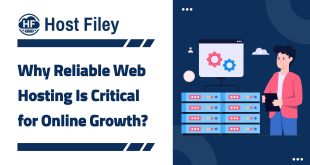Website speed is one of the most critical factors affecting user experience and search engine rankings. Slow websites lead to high bounce rates, reducing their chances of appearing in top search results. In this guide, we will explore the best practices for improving your website speed, highlighting how Host Filey hosting solutions can help accelerate websites.
1. Choose a Fast and Reliable Hosting Provider
Hosting plays a crucial role in your website’s loading speed. Even if you apply all optimization techniques, poor hosting will remain a major obstacle. Host Filey offers advanced high-speed hosting solutions, including:
- SSD NVMe servers, which enhance read/write speeds compared to traditional HDDs.
- Integrated CDN networks, ensuring fast loading from the closest geographic location to the visitor.
- Advanced caching technologies, such as LiteSpeed Cache, to improve page load times.
2. Enable Caching
Caching reduces resource consumption when loading repeated pages. You can improve performance by:
- Using caching plugins like WP Rocket or LiteSpeed Cache (available with Host Filey).
- Enabling Browser Caching to store static elements like images and CSS/JS files.
- Configuring Object Caching via Redis or Memcached.
3. Optimize and Compress Images
Images account for a significant portion of page size, so optimizing them is crucial for reducing load times:
- Use modern image formats like WebP.
- Compress images with tools like TinyPNG or Imagify.
- Implement Lazy Loading to load images gradually.
4. Optimize Code (CSS, JavaScript, HTML)
Uncompressed or poorly optimized code can slow down website loading. To enhance performance:
- Minify files using tools like Minify and Gzip Compression.
- Remove unnecessary code from CSS and JavaScript.
- Defer non-essential JavaScript using Async and Defer attributes.
5. Use a Content Delivery Network (CDN)
CDNs help deliver content to visitors from the nearest server, reducing response times. Host Filey integrates with Cloudflare and BunnyCDN to enhance loading speed.
6. Reduce HTTP Requests
The more HTTP requests your site makes, the longer it takes to load. To minimize them:
- Merge CSS and JavaScript files into fewer files.
- Use CSS Sprites for images.
- Host fonts and icons locally instead of relying on external sources.
7. Optimize the Database
Over time, unnecessary data accumulates in databases, slowing down queries. To prevent this:
- Use database optimization plugins like WP-Optimize.
- Delete old, unused posts and drafts.
- Regularly optimize MySQL tables via phpMyAdmin or WP-CLI.
8. Regularly Monitor Website Performance
You should continuously monitor your website speed using tools such as:
- Google PageSpeed Insights to analyze performance.
- GTmetrix to identify speed issues and solutions.
- Pingdom Tools for global speed testing.
Improving website speed is essential for ensuring a great user experience and achieving higher search engine rankings. By implementing these best practices and leveraging Host Filey high-performance hosting, you can significantly boost your website speed and enhance its online success.
 Host Filey – Blog
Host Filey – Blog

